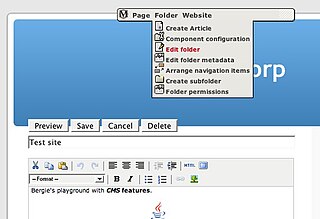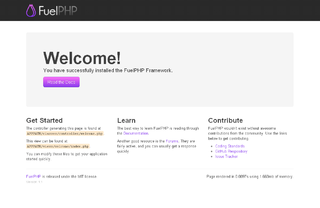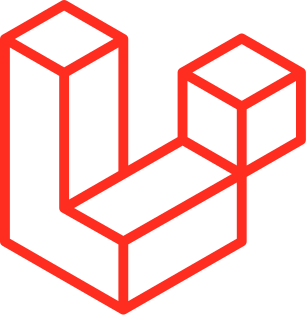
Model–View–Controller is a software architectural pattern commonly used for developing user interfaces which divides the related program logic into three interconnected elements. This is done to separate internal representations of information from the ways information is presented to and accepted from the user. Following the MVC architectural pattern decouples these major components allowing for code reuse and parallel development.

Midgard is an open source persistent storage framework. It provides an object-oriented and replicated environment for building data-intensive applications.

Django is a Python-based free and open-source web framework, which follows the model-template-view (MTV) architectural pattern. It is maintained by the Django Software Foundation (DSF), an independent organization established as a 501(c)(3) non-profit.
A web framework (WF) or web application framework (WAF) is a software framework that is designed to support the development of web applications including web services, web resources, and web APIs. Web frameworks provide a standard way to build and deploy web applications on the World Wide Web. Web frameworks aim to automate the overhead associated with common activities performed in web development. For example, many web frameworks provide libraries for database access, templating frameworks, and session management, and they often promote code reuse. Although they often target development of dynamic web sites, they are also applicable to static websites.

Catalyst is an open source web application framework written in Perl, that closely follows the model–view–controller (MVC) architecture, and supports a number of experimental web patterns. It is written using Moose, a modern object system for Perl. Its design is heavily inspired by such frameworks as Ruby on Rails, Maypole, and Spring.

Joomla is a free and open-source content management system (CMS) for publishing web content, developed by Open Source Matters, Inc. It is built on a model–view–controller web application framework that can be used independently of the CMS.
Zend Framework (ZF) is an open source, object-oriented web application framework implemented in PHP 7 and licensed under the New BSD License. The framework is basically a collection of professional PHP-based packages. The framework uses various packages by the use of Composer as part of its package dependency managers; some of them are PHPUnit for testing all packages, Travis CI for continuous Integration Services. Zend Framework provides to users a support of the Model View Controller (MVC) in combination with Front Controller solution. MVC implementation in Zend Framework has five main areas. The router and dispatcher functions to decide which controller to run based on data from URL, and controller functions in combination with the model and view to develop and create the final web page.

SilverStripe is a free and open source Content Management System (CMS) and Framework for creating and maintaining websites and web applications. It provides an out of the box web-based administration panel that enables users to make modifications to parts of the website, which includes a WYSIWYG website editor. The core of the software is SilverStripe Framework, a PHP Web application framework.
The ASP.NET MVC is a web application framework developed by Microsoft, which implements the model–view–controller (MVC) pattern. It is open-source software, apart from the ASP.NET Web Forms component which is proprietary.
The front controller software design pattern is listed in several pattern catalogs and related to the design of web applications. It is "a controller that handles all requests for a website", which is a useful structure for web application developers to achieve the flexibility and reuse without code redundancy.
Umbraco is an open-source content management system (CMS) platform for publishing content on the World Wide Web and intranets. It is written in C# and deployed on Microsoft based infrastructure. Since version 4.5, the whole system has been available under an MIT License.
ProcessWire is a free and open source content management system (CMS), content management framework (CMF) and web application framework (WAF) written in the PHP programming language. It is distributed under the Mozilla Public License 2.0. ProcessWire is built around an API with usage and naming conventions similar to the JavaScript framework jQuery. The stated goal behind the API is to provide the level of accessibility and control to pages in a website that jQuery provides to the DOM. Content is managed either via the API or the web-based admin control panel. ProcessWire is largely used for development of web sites, web applications, services, content feeds and related applications.

FuelPHP is an open-source web application framework written in PHP which implements the HMVC pattern.

Nette Framework is an open-source framework for creating web applications in PHP 5 and 7. It supports AJAX, DRY, KISS, MVC and code reusability. Original author of the framework is David Grudl, but further development is now maintained by the Nette Foundation organization. Nette is a free software released under both the New BSD license and the GNU GPL version 2 or 3.

Laravel is a free, open-source PHP web framework, created by Taylor Otwell and intended for the development of web applications following the model–view–controller (MVC) architectural pattern and based on Symfony. Some of the features of Laravel are a modular packaging system with a dedicated dependency manager, different ways for accessing relational databases, utilities that aid in application deployment and maintenance, and its orientation toward syntactic sugar.

Phalcon is a PHP web framework based on the model–view–controller (MVC) pattern. Originally released in 2012, it is an open-source framework licensed under the terms of the BSD License.
Gyroscope is an open source PHP framework and a code template system for building web backend systems. Gyroscope uses a specific and yet flexible user interaction model to reveal and explore the inner-relations of a database.

The Pop PHP Framework a free and open source PHP Web framework that was created by Nick Sagona. It is distributed under the BSD License and hosted on GitHub. The framework is intended to be utilized for rapid application development, with an emphasis on web applications.












